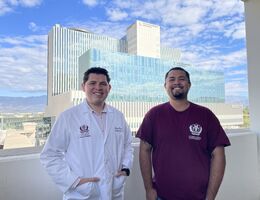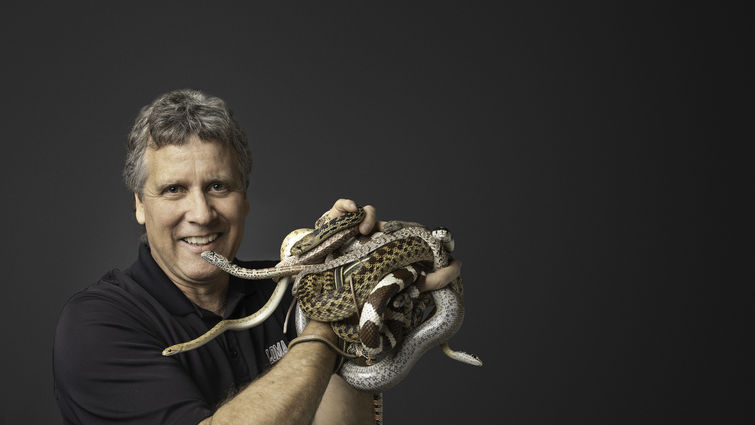

Bill Hayes — the zoologist who loves the toxic, cold-blooded, and misunderstood (Photo by Chet Williams)
After the sun goes down and the desert’s temperatures begin to drop, Bill Hayes, PhD, MS, and a group of students set out to catch, research, and photograph the creatures of the desert — snakes, rattlesnakes, geckos, scorpions, and spiders. The participating students from the Department of Earth and Biological Sciences at Loma Linda University School of Medicine learn up-close and personal from Hayes, who has been instrumental in breakthroughs in venom research.
Following graduation from Walla Walla University, Hayes went on to earn a PhD in zoology from the University of Wyoming in 1991. He began teaching at Loma Linda University in 1996. Until the COVID-19 pandemic, Hayes also hosted a twice-yearly community educational event with an array of animals at Loma Linda University Church. The wildly popular event, held since 2011, introduced children to animals from diverse habitats — animals as small as a scorpion and large as an elephant. “It’s a fun way to introduce children to the diversity of God’s creations,” Hayes says.
How did your interest in snakes become what it is today?
When growing up in Takoma Park, Maryland, my dad always seemed to have a snake or two in the house. Some of my most cherished memories were of tagging along behind him on a “snake hunt” during a family weekend outing.
Before long, my two brothers and I began keeping snakes ourselves. We often had up to a dozen in the basement, usually in their cages. As my remarkably tolerant mother can testify, snakes are incredibly deft escape artists.
What did you think you would be when you grew up?
I found myself enamored with many things. My earliest recollection was being impressed by the local trash collectors, but that soon gave way to becoming famous for extracting venom from snakes.
After spending a few weeks taking zoology in college, I saw the light: I wanted to teach at that level. After transferring to Walla Walla University, I was thrilled to learn that I could have a career doing research. I pictured myself initially becoming a marine biologist, but after discovering several rattlesnake dens in the hillsides of eastern Washington, I became hooked on studying rattlesnake behavior and ecology.
What other animals have you studied?
When scientists do research, every question they answer usually generates additional questions. With Ron Carter, our university’s Provost, I’ve studied the behavior, ecology and conservation of endangered rock iguanas in The Bahamas. They’re magnificent creatures. I also study rare and endangered birds there as well, island-hopping and camping on remote little islands with a noose in hand, binoculars around the neck and snorkel gear at the ready.
What do people often misunderstand about snakes?
Snakes evoke a myriad of emotions in humans, including both fear and fascination. One of the best parts about my job is that people love to hear and learn about snakes — rattlesnakes in particular.
Many people think these critters are out to kill us, but in reality, they want nothing to do with us. They’re shy, inquisitive creatures; but rattlesnakes are also easily frightened, and they’re equipped with a remarkable set of tools — sharp fangs, plenty of venom, and a blazing fast strike to defend themselves when necessary.
Where do you see your field going in the future?
For the animals I study, there’s an increasing focus on their ecology, especially as it relates to climate change. Even larger challenges include habitat loss, invasive species and spread of diseases. We humans do serious damage to the natural world, and I’m disappointed when I see people have become remarkably indifferent rather than faithful stewards of the planet.
For the venoms that fascinate me, there’s a need for better snakebite therapies and for the use of venoms to cure human disease. Animal venoms have a long history of interacting with physiological systems, so it should come as no surprise that humans have resourcefully tapped that fountain of potential to gift us with a number of life-saving drugs and molecular tools derived from venoms.
It seems contradictory, but through research and careful study, a substance like venom — designed to kill — can be used instead to heal and save lives.
More information about Earth & Biological Sciences at Loma Linda University is available online.


